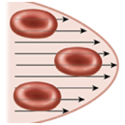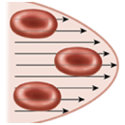Bubble trouble
For decades, ultrasonic imaging has been used by doctors for purposes ranging from diagnosing heart problems to checking on the course of pregnancy. In recent years, clinicians have been using “contrast agents” that induce microbubble formation to improve the quality of the imaging, particularly for assessing tissues and blood vessels in the heart. However, the US Food and Drug Administration has raised concerns that these microbubbles may be causing damage. Writing in Physical Review Letters, Hong Chen and colleagues at the University of Washington, Seattle, in the US, report their efforts to study this problem by imaging how microbubbles behave in blood vessels under ultrasound exposure.
Chen et al. used rat abdominal tissue in saline solution, injected with lipid-coated microbubbles, as their model system. The researchers applied ultrasound pulses while taking high-speed movies of the bubble-vessel interactions under a microscope. They found that the ultrasonically exposed bubbles would produce microjets and cause the blood vessel walls to bend inwards and outwards. According to the authors, this complex dynamic behavior depends sensitively on the viscoelastic properties of the tissue material and their observations provide a starting point for assessing ultrasonically induced microbubble damage. – David Voss





